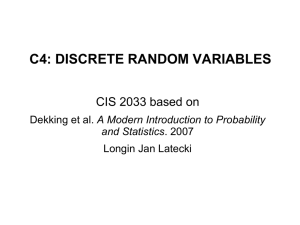Bernoulli Random Variable
advertisement
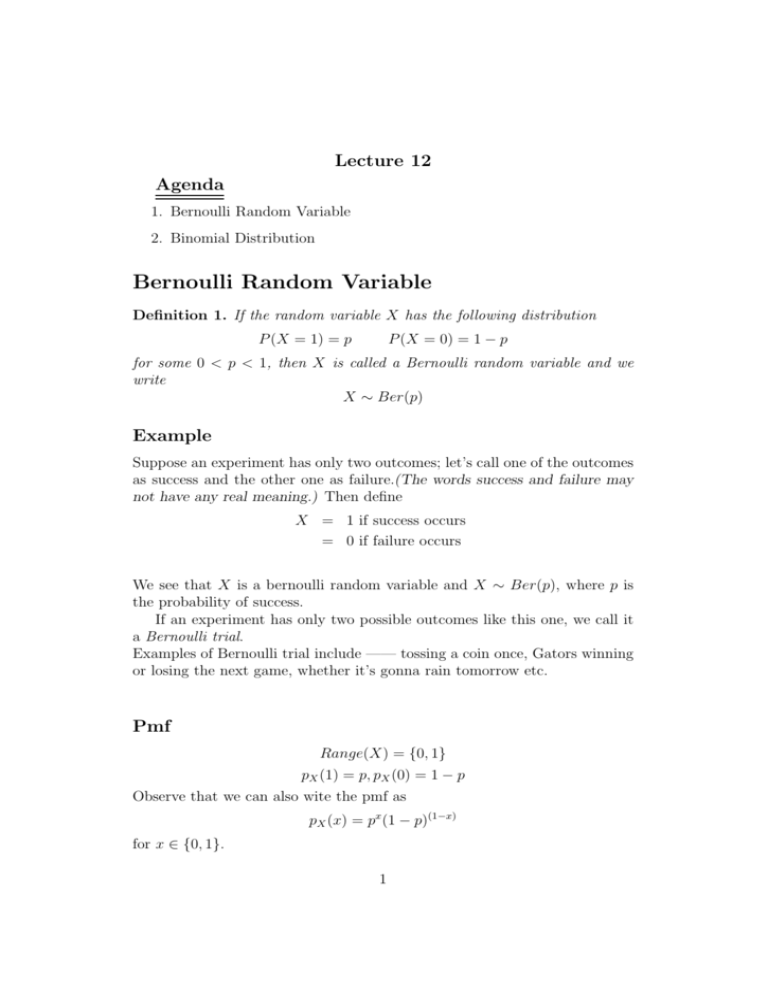
Lecture 12
Agenda
1. Bernoulli Random Variable
2. Binomial Distribution
Bernoulli Random Variable
Definition 1. If the random variable X has the following distribution
P (X = 0) = 1 − p
P (X = 1) = p
for some 0 < p < 1, then X is called a Bernoulli random variable and we
write
X ∼ Ber(p)
Example
Suppose an experiment has only two outcomes; let’s call one of the outcomes
as success and the other one as failure.(The words success and failure may
not have any real meaning.) Then define
X = 1 if success occurs
= 0 if failure occurs
We see that X is a bernoulli random variable and X ∼ Ber(p), where p is
the probability of success.
If an experiment has only two possible outcomes like this one, we call it
a Bernoulli trial.
Examples of Bernoulli trial include —— tossing a coin once, Gators winning
or losing the next game, whether it’s gonna rain tomorrow etc.
Pmf
Range(X) = {0, 1}
pX (1) = p, pX (0) = 1 − p
Observe that we can also wite the pmf as
pX (x) = px (1 − p)(1−x)
for x ∈ {0, 1}.
1
Mean and Variance
Let X ∼ Ber(p).
E(X) = 1 × p + 0 × (1 − p) = p
E(X 2 ) = 12 × p + 02 × (1 − p) = p
V (X) = E(X 2 ) − [E(X)]2 = p − p2 = p(1 − p)
Binomial Distribution
Let’s begin with the following example. I have a coin where P (Heads) = p
and P (T ails) = (1 − p).
Toss it once::
Let X denote the number of heads. Then X ∼ Ber(p), because you can
either get heads(X = 1) or tails(X = 0) with probabilities p and (1 − p).
Toss it n times::
Let X denote the number of heads. Then Range(X) = {0, 1, 2, . . . , n}.
For k ∈ {0, 1, 2, . . . , n},
n k
P (X = k) =
p (1 − p)(n−k)
k
WHY ?
X = k corresponds to nk many outcomes; because,
out of the n tosses choose
n
the k tosses where you will have heads in k many ways, and put the tails
in the remaining (n − k) positions. For each of these outcomes we have k
heads and (n − k) tails and hence the probability for each of those outcomes
= pk (1 − p)(n−k)
Definition 2. For 0 < p < 1 and a number n ≥ 1, a random variable X is
said to follow the Binomial distribution with parameters n and p; [written
as X ∼ Bin(n, p)] if
Range(X) = {0, 1, 2, . . . , n}
and for 0 ≤ k ≤ n
n k
P (X = k) =
p (1 − p)(n−k)
k
2
Natural situation for binomial distribution
Suppose there is a Bernoulli experiment with probability of success p and
probability of failure (1−p). You are repeating the experiment independently
n times. Then X the number of successes, follow Bin(n, p).
In fact suppose for i = 1, 2, . . . , n, let
Xi = 1 if i-th experiment results in success
= 0 if i-th experiment results in failure
then we observe that
X = X1 + X2 + . . . + Xn
and
X ∼ Bin(n, p)
Pmf
Let X ∼ Bin(n, p). For x ∈ {0, 1, 2, . . . , n}
n x
pX (x) =
p (1 − p)(n−x)
x
Observe one thing that we got free out of all this
Lemma 1. If 0 < p < 1 and n ≥ 1,
n X
n k
p (1 − p)(n−k) = 1
k
k=0
Mean and Variance
If X ∼ Bin(n, p), then
E(X) = np
V (X) = np(1 − p)
Proof.
E(X) = E(X1 + X2 + . . . + Xn ) = E(X1 ) + E(X2 ) + . . . + E(Xn ) = np
since each Xi ∼ Ber(p)
3
Now there is a result that says that if Y1 , Y2 , . . . , Yk arised out of k independent experiments then
V (Y1 + Y2 + . . . + Yk ) = V (Y1 ) + V (Y2 ) + . . . + V (Yk )
We apply that result to get
V (X) = V (X1 ) + V (X2 ) + . . . + V (Xn ) = np(1 − p)
If you are not happy with the proof for variance, because it uses an
unproved result, please go to page 107-108 of the text book, for a rigorous
algebraic proof.
CAUTION We have used V (Y1 +Y2 +. . .+Yk ) = V (Y1 )+V (Y2 )+. . .+V (Yk )
in the above proof, but take note that this equality does not always hold.
Homework ::
3.36b, 3.40, 3.41, 3.50, 3.54 a-b
4
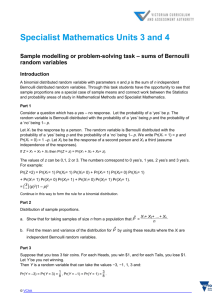
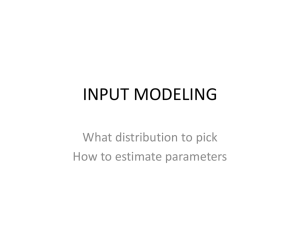
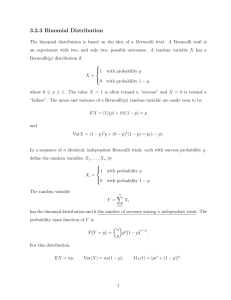
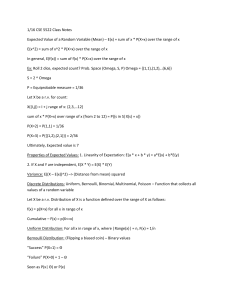
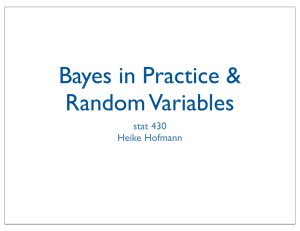

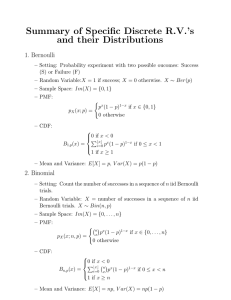


![2*V[X]=1/n2*np(1-p)=p(1-p)/n 1833.0 5.05.0 !8!6 !14 )6 ( = = = XP](http://s3.studylib.net/store/data/008711824_1-0d6d751ef61e41cbf10ab5a47ea15653-300x300.png)
